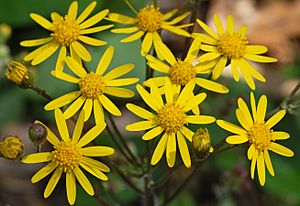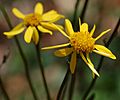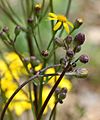Golden ragwort facts for kids
Quick facts for kids Golden ragwort |
|
|---|---|
 |
|
| Scientific classification | |
| Synonyms | |
|
Senecio aureus L. |
Packera aurea (formerly Senecio aureus), commonly known as golden ragwort, is a beautiful yellow flower. It is a perennial plant, which means it lives for more than two years. This plant belongs to the Asteraceae family, just like sunflowers and daisies! You might hear it called by many other names too, such as golden groundsel or life root.
This lovely flower grows naturally in eastern North America. You can find it from places like Labrador in Canada all the way down to Florida in the United States. It also spreads west to Minnesota and Arkansas.
Golden Ragwort Gallery
Historical Uses of Golden Ragwort
In the past, Golden Ragwort was used in traditional medicine. It was especially important to Native Americans for various treatments. A group of doctors called the Eclectics also used this plant. They called it "life root" and used it as a tonic. It was even an ingredient in a famous old medicine called Lydia Pinkham's compound.
Today, this plant is not used much in modern medicine. This is because it contains natural chemicals that can be harmful if not used correctly. For safety, it is best not to use this plant for medicinal purposes without expert guidance.
Golden Ragwort and the Cinnabar Moth
The Golden Ragwort has a special connection with the cinnabar moth. This moth mostly eats ragwort plants. Because of this, the cinnabar moth has sometimes been brought to new places. This helps control the growth of ragwort where it has become too widespread. It's a natural way to manage the plant!






